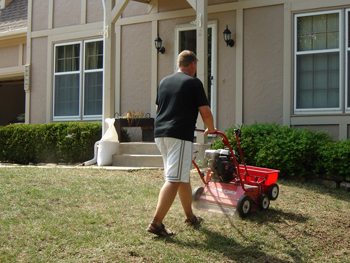September: Time to Reseed Cool Season Lawns

Traditionally September is considered the most important month for care of our cool season lawns, bluegrass and tall fescue. These grasses thrive in the cool of the spring and fall, and stress or even go into dormancy in the dog days of summer. The arrival of September with the milder conditions helps revive the summer stressed turf. It naturally wants to grow and thrive. This is why it is important we give the grass what it needs to fully recover from the stress of summer.
Time to Seed
September is not only good for fertilizing it is also the ideal time to sow new grass seed. September conditions are perfect with warm soils, bright sunshine and cooler nights to establish a new lawn. Successful lawn seeding does require a little thought and a few guidelines to follow. It is not as simple as just throwing out seed and letting nature take its course.
Successful overseeding requires good soil preparation to help improve the contact between the small seeds and the soil. The ideal way to prepare the soil for seeding is to verticut. Think of a verticutter as a machine with a spindle of closely spaced saw blades spinning through the turf. As these blades cut or slice through the soil they open up grooves that allow the seeds to fall and be covered up for good germination.
Before verticutting mow the turf lower and make sure there is good soil moisture so the blades can penetrate the soil. Make one to two passes and then rake up the debris. After that you are ready to seed. Then comes the hard part of making sure the seedbed is moist at all times. Grass seeding requires dedication to watering as it takes even moisture to get a good stand of grass. Most grass seed will germinate within one to two weeks of seeding, and then the amount of water can be reduced.
Seeding is also more successful with an application of a starter type fertilizer. Instead of the high nitrogen application recommended, use a more balanced fertilizer or one with more phosphorus such s 10-20-10. Research has shown that phosphorus placed at the point of germination speeds up establishment. But remember for most lawns the phosphorus is only needed when seeding. Be careful not to starve your lawn with too little nitrogen. A month after the new grass has germinated apply a high nitrogen fertilizer to push the grass for quicker establishment before the arrival of cooler fall and winter temperatures.
Other Resources
Have questions? The Garden Hotline is staffed by trained EMG volunteers and Extension staff who will assist you with questions.
Phone: (913) 715-7050
Email: garden.help@jocogov.org